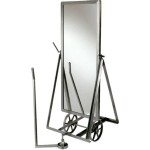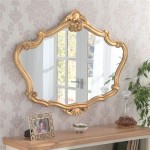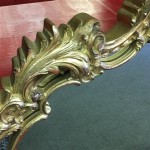```html
Spray Painting A Wooden Mirror Frame
Spray painting a wooden mirror frame offers a cost-effective and efficient method for updating its appearance or giving it a fresh new look. Whether aiming to revitalize an old frame, match it to a specific décor, or protect the wood from environmental elements, spray painting provides a smooth, even finish that can be challenging to achieve with traditional brush painting methods. This article details the process, outlining the necessary preparations, essential materials, and step-by-step instructions for successfully spray painting a wooden mirror frame.
Before initiating the spray painting process, careful preparation of the workspace and the mirror frame itself is paramount. Failing to adequately prepare can result in a subpar finish, including drips, uneven coverage, or poor adhesion of the paint, ultimately detracting from the overall aesthetic appeal of the mirror.
Preparing the Workspace and Mirror Frame
The initial step involves selecting a suitable workspace. Ideally, this should be an open, well-ventilated area, free from dust and debris. Outdoors is often preferable, but considerations should be made for weather conditions like wind, which can carry unwanted particles onto the wet paint. If working indoors, ensure adequate ventilation by opening windows and using a fan to circulate air. Lay down drop cloths or plastic sheeting to protect the surrounding surfaces from overspray. This is crucial to prevent paint from adhering to unwanted areas like floors, furniture, or nearby walls.
Next, the mirror itself must be protected. Masking tape and paper or plastic sheeting should be used to completely cover the glass surface, ensuring that no paint comes into contact with it. Apply the masking tape firmly along the edges of the frame, creating a clean, sharp line. Overlap the masking tape slightly onto the glass to prevent paint from seeping underneath. Once the tape is in place, cover the remaining glass surface with paper or plastic sheeting, securing it to the masking tape with additional tape. This creates a barrier that protects the mirror from overspray and accidental paint marks.
The wooden frame then requires thorough cleaning. Use a damp cloth with mild soap and water to remove any dirt, dust, or grime that may have accumulated on the surface. Pay close attention to crevices and corners, ensuring that all contaminants are removed. Allow the frame to dry completely before proceeding to the next step. This cleaning process is crucial for ensuring proper adhesion of the primer and paint.
Once the frame is clean and dry, inspect it for any imperfections, such as scratches, dents, or uneven areas. These imperfections should be addressed before painting to achieve a smooth, professional finish. Use wood filler to fill in any holes or cracks, following the manufacturer's instructions for application and drying time. Once the wood filler is dry, sand it smooth with fine-grit sandpaper, blending it seamlessly with the surrounding wood. Sanding the entire frame is also recommended, even if there are no visible imperfections. This creates a slightly textured surface that provides better adhesion for the primer and paint.
Selecting the Right Materials
Choosing the appropriate materials is vital for achieving a durable and aesthetically pleasing finish. The selection of primer, paint, and application tools significantly impacts the outcome of the spray painting project. Investing in high-quality materials can save time and effort in the long run, resulting in a more professional and lasting result.
Primer is an essential component of spray painting a wooden frame. It serves as a base coat that improves adhesion of the paint, seals the wood, and prevents the paint from being absorbed into the wood. A good primer will also help to create a uniform surface, concealing any minor imperfections that may remain after sanding. Choose a primer specifically designed for wood surfaces. Apply the primer in thin, even coats, following the manufacturer's instructions for drying time. Multiple thin coats are preferable to one thick coat, as they are less likely to drip or run.
The selection of paint depends on the desired finish and the intended use of the mirror. Acrylic latex paints are a popular choice for wooden frames due to their durability, ease of application, and water-based formula, which makes them easy to clean up. Oil-based paints offer excellent durability and a smooth, glossy finish, but they require mineral spirits for cleanup and may release stronger odors. Consider the color and sheen of the paint carefully. Semi-gloss or gloss finishes are more durable and easier to clean, while matte finishes offer a more subtle and contemporary look. Choose a paint that is compatible with the primer used, ensuring that they are designed to work together.
In addition to primer and paint, several other materials are required for spray painting. These include:
- Spray paint can with appropriate nozzle. Invest in a high-quality spray can with an adjustable nozzle to ensure even coverage and minimize drips.
- Masking tape and paper or plastic sheeting for protecting the mirror.
- Drop cloths or plastic sheeting for protecting the surrounding workspace.
- Fine-grit sandpaper for smoothing the wood surface and sanding between coats.
- Tack cloth for removing dust particles.
- Wood filler for repairing any imperfections in the wood.
- Safety glasses and a respirator or mask for protecting the eyes and lungs from paint fumes.
- Gloves for protecting the hands from paint.
- A well-ventilated workspace.
Applying the Spray Paint
The actual application of the spray paint requires patience and attention to detail. Proper technique is essential for achieving a smooth, even finish without drips, runs, or orange peel texture. Practice on a scrap piece of wood before painting the mirror frame to get a feel for the spray can and ensure that the paint is applying evenly.
Before spraying, shake the spray paint can vigorously for at least two minutes to ensure that the paint is thoroughly mixed. Hold the can approximately 8-10 inches away from the surface of the frame, keeping it moving at a consistent speed. Apply the paint in thin, even coats, overlapping each stroke slightly. Avoid holding the can in one place for too long, as this can cause drips and runs. Multiple thin coats are preferable to one thick coat, as they allow the paint to dry more evenly and reduce the risk of imperfections.
When spraying corners and edges, use short, controlled bursts of paint to avoid buildup. Pay close attention to the direction of the spray, ensuring that the paint is reaching all areas of the frame. If necessary, rotate the frame to access hard-to-reach areas. After applying the first coat, allow it to dry completely according to the manufacturer's instructions. This usually takes at least 30 minutes to an hour, depending on the type of paint and environmental conditions.
Once the first coat is dry, lightly sand the surface with fine-grit sandpaper to remove any imperfections, such as dust particles or orange peel texture. Wipe the frame clean with a tack cloth to remove any sanding dust. Apply a second coat of paint, following the same technique as the first coat. If necessary, apply a third coat for complete coverage and a smooth, even finish. Allow the final coat of paint to dry completely before removing the masking tape and paper or plastic sheeting from the mirror. This ensures that the paint is fully cured and will not be damaged during the removal process.
After the final coat is completely dry, carefully remove the masking tape and protective covering from the mirror. Pull the tape away from the frame at a 45-degree angle to avoid chipping the paint. Inspect the frame for any imperfections or areas that may require touch-up. If necessary, use a small brush to apply touch-up paint to any damaged areas. Allow the touch-up paint to dry completely before handling or displaying the mirror.
Following these steps will result in a beautifully spray-painted wooden mirror frame that enhances the aesthetic appeal of any space. The key to success lies in careful preparation, the selection of high-quality materials, and the application of proper spray painting techniques.
```
How To Spray Paint A Mirror Frame Perfect Beginner Diy Project Design Morsels

How To Paint A Mirror Frame We Moved Visit Ashleyburk Com

Spray Painted Gold Yard Mirror How To Paint A Frame

How To Spray Paint A Mirror Frame Perfect Beginner Diy Project Design Morsels

How To Paint A Mirror Frame

How To Spray Paint A Mirror Frame Perfect Beginner Diy Project Design Morsels

Spray Painted Rainbow Mirror Makeover Colorshot Paint

How To Spray Paint A Mirror Frame Perfect Beginner Diy Project Design Morsels

How To Spray Paint A Mirror Frame Painting Frames

How To Spray Paint A Mirror








